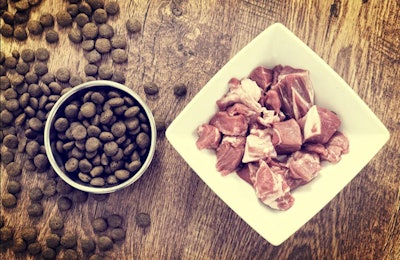
Since the COVID-19 pandemic first hit the largest pet food market, the U.S., various industry voices have raised concerns about possible pending effects on the ingredient supply chain. With the bleak news coming out of the U.S. meat industry these days regarding its supply chain and operation problems, those worries seem to have hit a new level. Are they warranted?
Many common protein ingredients used in pet food come directly from the meat and poultry supply chain, such as meals, organ meat and other rendered by-products. So it stands to reason that the plant closures and distribution disruptions happening in that chain would have an impact on pet food.
Yet experts at industry-related organizations such as the North American Renderers Association (NARA) and American Feed Industry Association (AFIA) say the pet food supply chain is not being affected significantly to date. At the same time, we’re hearing – anecdotally and strictly off the record – from pet food manufacturers and ingredient suppliers that they are indeed experiencing ingredient shortages. What gives?
The big picture: meat and poultry disruptions
Early on, as cases of COVID-19 began spreading across the U.S., meat demand on the food service and institutional side of processors’ businesses dropped off a cliff, as restaurants, schools and other large customers closed. Simultaneously, demand on the consumer and retail side, especially in grocery stores, soared, causing at least temporary shortages.
Now, according to large meat processors such as Tyson facing multiple plant closures, those shortages could become more significant and long term. Tyson, which closed three of its beef and pork processing plants due to COVID-19 infections, even took out full-page newspaper ads declaring, “The food supply chain is breaking” and warning that “millions of pounds of meat” are at risk of disappearing from the food chain. (Since then, President Donald Trump has issued an executive order to keep meat and poultry processing plants running.)
While poultry – a more common ingredient in pet food than beef or pork – seems to be suffering fewer plant closures, the abrupt changes in demand have been a real problem. “Facilities designed to efficiently produce made-to-order specially sized foodservice products on a just-in-time basis can’t turn on a dime and bring in different-size birds to produce retail packages of meat and parts,” wrote my colleague Terrence O’Keefe, content director for Watt Global Media. (Note: Watt Global Media is Petfood Industry’s parent company.)
NARA, AFIA: pet food ingredient supply holding up for now
Poultry meal was the first pet food ingredient we heard about being in short supply – again, anecdotally and off the record – starting about the second or third week of April. Since then, we have also heard concerns about other poultry proteins, impending shortages of beef and pork-based ingredients due to that supply chain disruption as well as micro ingredients and possibly even commodities.
Still, David Meeker, Ph.D., senior vice president of scientific services for NARA, said if closed meat and poultry processing plants are reopened soon, he doesn’t foresee a huge hit to the supply of co-products (rendered proteins) for pet food. He did acknowledge localized or small-scale shortages for renderers and said the dramatic shift in demand from foodservice to retail has affected the cuts of meat and stream of material available to renderers. “We’re gaining some and we’re losing some,” he said.
In addition, due to the initial spike in pet food sales in the U.S. as pandemic-driven shelter-in-place orders proliferated, there was a resulting rise in demand for rendered products, by as much as 30% in some cases, Meeker said. “That kind of increase is going to cause some spot shortages, and maybe some increased prices and maybe inability to fill all those orders, but I expect normal amounts to be produced without a lot of problems, unless things get a lot worse.”
Leah Wilkinson, vice president of public policy and education for AFIA, provided a similar outlook regarding micro ingredients, because the U.S. pet food and livestock feed industries began reacting to COVID-19 while it was still mainly in China only, she said, and also learned from the ongoing African swine fever outbreak there that erupted in 2019 and has affected some ingredient supplies.
“We know that China is a significant exporter and source of vitamins and amino acids in particular,” Wilkinson added. “We’ve been able to monitor the situation and we knew there would be tightening of supply, from when they closed and until whenever they opened. The industry jumped on top early to keep access to those ingredients … Relationships with suppliers around the world allowed diversifying the supply chain.”
Like Meeker, though, Wilkinson did say that if pandemic-driven disruptions continue for a long time, there could potentially be some problems for the ingredient supply chain. Meanwhile, she said AFIA and other industry partners have begun discussions with the Food and Drug Administration about helping pet food manufacturers deal with potential labeling changes due to the possible need to substitute ingredients or change their order in formulations.
No public information on specific ingredient shortages
Other regions of the world, including Europe and Southeast Asia, have also experienced disruptions in their agriculture, meat and feed supply chains, which likely are affecting pet food, too. Yet in a global survey of pet food manufacturers in our Petfood Industry audience, only 12% identified ingredient shortages or inconsistent supply as their top challenge resulting from the COVID-19 pandemic.
Of course, even if it’s not their top challenge (for 39% of these pet food manufacturers, keeping their employees safe and healthy is), survey respondents not selecting that option may still be experiencing ingredient shortages. Among 20 comments provided to that question in the survey, one mentioned corn gluten meal, another fresh ingredients from certain providers in Malaysia and one, just supply chain delays in general.
Aside from those comments, it’s difficult to know the specific shortages pet food companies are experiencing or their level of severity because no one will make that information available publicly. Perhaps brands want to avoid alarming their customers over possible shortages of their pets’ food or are worried about giving competitors an advantage if they acknowledge ingredient shortages.
While we all hope any ingredient shortages are temporary due to the increased demand and meat/poultry and other supply disruptions, the continuing uncertainty we all feel about this unprecedented crisis likely only ratchets up anxiety over current or potential shortfalls. Typically, that type of anxiety is expressed privately within closed manufacturer-supplier relationships or among industry contacts – and understandably, not for public consumption or discussion.
If you do feel comfortable contributing information about your company’s experiences with ingredient supplies, please email me at [email protected].
View our continuing coverage of the coronavirus/COVID-19 pandemic.


















